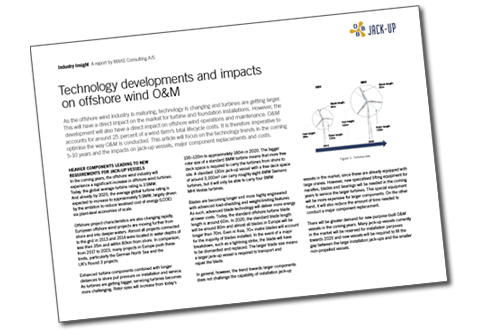
The offshore wind industry has paid little attention to outage time. This claim is made by MAKE Consulting in a recently released report about offshore wind O&M in Northern Europe.
The report describes that turbines are becoming larger, with the current average of 3.9 MW expected to increase to 5.9 MW by 2020. But this means that losses associated with downtime will become even more costly, particularly from failure of major components. As a result, service providers are forced to implement strategies to reduce downtime from major component failures.
One of the keys to reducing downtime is cutting the time it takes to replace a major component. The two weeks it might take to replace a component is no longer good enough, and some turbine OEMs and wind farm owners are introducing 48-hour targets, for example. The implications of these quicker replacement times on outage costs are significant, especially for larger turbines. MAKE Consulting claims a reduction in outage losses of EUR 56,000 for a 3 MW turbine compared with EUR 155,000 for an 8 MW turbine.
O&M framework agreements
The report points out the benefits of increased cooperation among operators who are willing to share service jack-up vessels across clusters of wind farms. In addition, more efficient planning will ensure that equipment and tools are available for use by the O&M vessel.
So how realistic is a 48-hour major component replacement? To start with, securing a vessel sharing or framework agreement with your jack-up provider plays an important part. This ensures that contractual terms and conditions are in place before maintenance work is required, which reduces outage days from the outset.
This is a view making waves at both utilities and OEMs. Keith Cooke, Operations Manager at E.ON’s Scroby Sands, believes that partnerships and framework agreements will help drive down levelised costs of energy (LCOE), saying: “I think we would all benefit if different parties could work closer together by having agreements in place to ensure assistance is available when needed.”
Also at MHI Vestas, framework agreements are seen as a natural step and has recently entered into such an agreement for offshore wind O&M services with DBB Jack-Up. Senior director Asger Pedersen believes it will facilitate more efficient planning and execution of MHI Vestas’ O&M tasks.
Game changer
In addition, site survey data needs to be kept up to date, so the service provider can get straight to work knowing what seabed conditions to expect and how to plan for the site-specific challenges.
Accommodation vessels are changing the game, too. But with the range of options available, including floating hotels, accommodation jack-ups and Service Operation Vessels (SOVs), it can be unclear which is the best option. SOVs seem to be the preferred option today, but they may not offer the comfort of the jack-ups, which could be necessary to attract and retain the best technicians. Valuable time can be gained by ensuring that the optimal accommodation solution is included within the O&M planning.
With the huge savings in outage costs a definite motivating factor, there are key decisions to be made. The challenge is surmountable, but it needs more openness and collaboration among key industry players to make it a reality.
